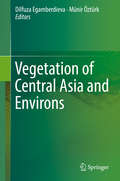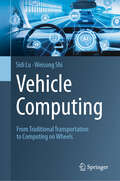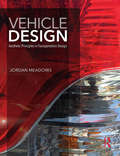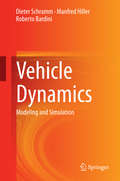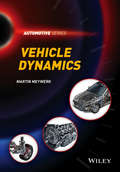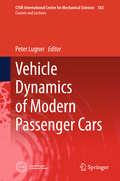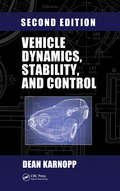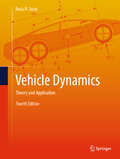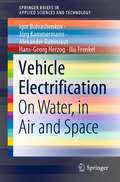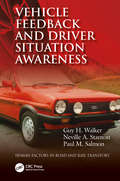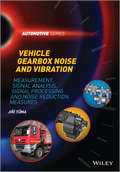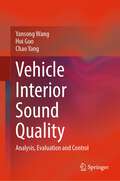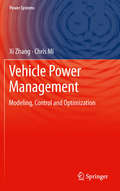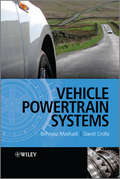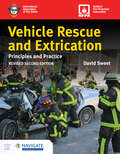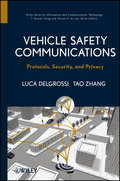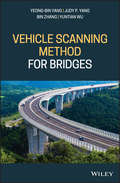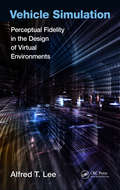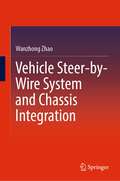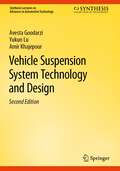- Table View
- List View
Vegetation of Central Asia and Environs
by Dilfuza Egamberdieva Münir ÖztürkCentral Asia is a large and understudied region of varied geography, ranging from the high passes and mountains of Tian Shan, to the vast deserts of Kyzyl Kum, Taklamakan to the grassy treeles steppes.This region is faced with adverse conditions, as much of the land is too dry or rugged for farming. Additionally, the rich specific and intraspecific diversity of fruit trees and medicinal plants is threatened by overgrazing, oil and mineral extraction, and poaching. Countless species from the approximately 20 ecosystems and 6000 plant taxa are now rare and endangered.Traditional vegetation studies in this region are far from adequate to handle complex issues such as soil mass movement, soil sodicity and salinity, biodiversity conservation, and grazing management. However, data analysis using a Geographical Information System (GIS) tool provides new insights into the vegetation of this region and opens up new opportunities for long-term sustainable management. While vegetation planning can occur at a property scale, it is often necessary for certain factors, such as salinity, to be dealt with on a regional scale to ensure their effective management. GIS increases the effectiveness and accuracy of vegetation planning in a region. Such regional planning will also greatly increases biodiversity values.This book systematically explores these issues and discuses new applications and approaches for overcoming these issues, including the application of GIS techniques for sustainable management and planning. Professional researchers as well as students and teachers of agriculture and ecology will find this volume to be an integral resource for studying the vegetation of Central Asia.
Vehicle Computing: From Traditional Transportation to Computing on Wheels
by Weisong Shi Sidi LuOver the past century, vehicles have predominantly functioned as a means of transportation. However, as vehicular computation and communication capacities continue to expand, it is anticipated that upcoming connected vehicle (CVs) will not only serve their conventional transport functions but also act as versatile mobile computing platforms. This book presents the concept of Vehicle Computing, encompassing five primary functionalities of CVs: computation, communication, energy management, sensing, and data storage. It proposes a potential business model and explores the challenges and opportunities associated with these domains. Vehicle Computing serves as an important resource for the research community and practitioners in the field of edge computing and cyber physical system, capturing the essence of a rapidly changing industry, addressing the challenges and opportunities associated with connected vehicles (including software-defined vehicles, autonomous vehicles, electric vehicles), machine learning, communication, sensing, data storage, energy management, and computer systems. It synthesizes the latest research and real-world applications, offering valuable insights to both academia and industry professionals. Vehicle Computing covers topics such as: The fundamentals of Vehicle Computing, including its historical context and key components. Advanced communication and networking technologies for connected vehicles. Sensing and data acquisition techniques, including edge and cloud computing integration. Energy management and storage, focusing on electric vehicle infrastructure and vehicle-to-grid. Data storage and processing strategies for vehicular environments. Business models, opportunities, and challenges associated with Vehicle Computing. Real-world applications and case studies, highlighting best practices and future trends.
Vehicle Crash Mechanics
by Matthew HuangGoverned by strict regulations and the intricate balance of complex interactions among variables, the application of mechanics to vehicle crashworthiness is not a simple task. It demands a solid understanding of the fundamentals, careful analysis, and practical knowledge of the tools and techniques of that analysis.Vehicle Crash Mechanics s
Vehicle Design: Aesthetic Principles in Transportation Design
by Jordan MeadowsVehicle Design guides readers through the methods and processes designers use to create and develop some of the most stunning vehicles on the road. Written by Jordan Meadows, a designer who worked on the 2015 Ford Mustang, the book contains interviews with design directors at firms including Fiat Chrysler Automobiles, Hyundai Motor Group, and Ford Motor Company, amongst other professionals. Case studies from Ford, Mazda, and Jeep illustrate the production process from research to execution with more than 245 color behind-the-scenes images in order to help readers create vehicles drivers will cherish.
Vehicle Dynamics
by Dieter Schramm Manfred Hiller Roberto BardiniThe authors examine in detail the fundamentals and mathematical descriptions of the dynamics of automobiles. In this context different levels of complexity will be presented, starting with basic single-track models up to complex three-dimensional multi-body models. A particular focus is on the process of establishing mathematical models on the basis of real cars and the validation of simulation results. The methods presented are explained in detail by means of selected application scenarios.
Vehicle Dynamics
by Martin MeywerkComprehensively covers the fundamentals of vehicle dynamics with application to automotive mechatronics Presents a number of different design, analysis and implementation considerations related to automobiles, including power requirements, converters, performance, fuel consumption and vehicle dynamic models Covers the dynamics, modeling and control of not only the entire vehicle system, but also of key elements of the vehicle such as transmissions, and hybrid systems integration Includes exercise problems and MATLAB® codes Accompanied by a website hosting animations
Vehicle Dynamics and Control
by Rajesh RajamaniVehicle Dynamics and Control provides a comprehensive coverage of vehicle control systems and the dynamic models used in the development of these control systems. The control system applications covered in the book include cruise control, adaptive cruise control, ABS, automated lane keeping, automated highway systems, yaw stability control, engine control, passive, active and semi-active suspensions, tire-road friction coefficient estimation, rollover prevention, and hybrid electric vehicles. In developing the dynamic model for each application, an effort is made to both keep the model simple enough for control system design but at the same time rich enough to capture the essential features of the dynamics. A special effort has been made to explain the several different tire models commonly used in literature and to interpret them physically. In the second edition of the book, chapters on roll dynamics, rollover prevention and hybrid electric vehicles have been added, and the chapter on electronic stability control has been enhanced. The use of feedback control systems on automobiles is growing rapidly. This book is intended to serve as a useful resource to researchers who work on the development of such control systems, both in the automotive industry and at universities. The book can also serve as a textbook for a graduate level course on Vehicle Dynamics and Control.
Vehicle Dynamics of Modern Passenger Cars (CISM International Centre for Mechanical Sciences #582)
by Peter LugnerThe book provides the essential features necessary to understand and apply the mathematical-mechanical characteristics and tools for vehicle dynamics including control mechanism. An introduction to passenger car modeling of different complexities provides the basics for the dynamical behavior and presents vehicle models later used for the application of control strategies. The presented modeling of the tire behavior, also for transient changes of the contact patch properties, shows the necessary mathematical descriptions used for the simulation of the vehicle dynamics. The introduction to control for cars and its extension to complex applications using e.g. observers and state estimators is a main part of the book. Finally the formulation of proper multibody codes for the simulation leads to the integration of all parts. Examples of simulations and corresponding test verifications show the profit of such a theoretical support for the investigation of the dynamics of passenger cars.
Vehicle Dynamics, Stability, and Control (Mechanical Engineering)
by Dean KarnoppAnyone who has experience with a car, bicycle, motorcycle, or train knows that the dynamic behavior of different types of vehicles and even different vehicles of the same class varies significantly. For example, stability (or instability) is one of the most intriguing and mysterious aspects of vehicle dynamics. Why do some motorcycles sometimes exh
Vehicle Dynamics: Fundamentals and Ultimate Trends (CISM International Centre for Mechanical Sciences #603)
by Basilio LenzoThis book examines the fundamentals of vehicle dynamics, as well as the recent trends in the field, such as torque vectoring control, vehicle state estimation, and autonomous vehicles. It investigates the most pressing problems that vehicle dynamics engineers have been facing nowadays, and the challenges of autonomous vehicles in terms of perception, path planning, and analysis of the road environment. The book will serve as a useful tool for graduate students and researchers in vehicle dynamics and control.
Vehicle Dynamics: Theory and Application
by Reza N. JazarVehicle Dynamics: Theory and Application offers comprehensive coverage of fundamental and advanced topics in vehicle dynamics. This class-tested guide is designed for senior undergraduate and first-year graduate students pursuing mechanical and automotive engineering degrees. It covers a wide range of concepts in detail, concentrating on practical applications that enable students to understand, analyze, and optimize vehicle handling and ride dynamics. Related theorems, formal proofs, and real-world case examples are included. The textbook is divided into four parts, covering all the essential aspects of vehicle dynamics: Vehicle Motion: covers tire dynamics, forward vehicle dynamics, and driveline dynamics Vehicle Kinematics: covers applied kinematics, applied mechanisms, steering dynamics, and suspension mechanisms Vehicle Dynamics: covers applied dynamics, vehicle planar dynamics, and vehicle roll dynamics Vehicle Vibration: covers applied vibrations, vehicle vibrations, and suspension optimization. This revised edition adds an engineering perspective to each example, highlighting the practical relevance of mathematical models and helping you understand when experimental results may differ from analytical ones. New coverage includes vehicle vibrations in transient responses and the control concept in ride optimization. Students, researchers, and practicing engineers alike will appreciate the user-friendly presentation of the science and engineering of the mechanical aspects of vehicles, emphasizing steering, handling, ride, and related components.
Vehicle Electrification: On Water, in Air and Space (SpringerBriefs in Applied Sciences and Technology)
by Ilia Frenkel Igor Bolvashenkov Hans-Georg Herzog Jörg Kammermann Alexander RubinrautThis book provides a comprehensive assessment and presentation of various feasible application of electric propulsion system, considering their weight, volume, reliability, and fault tolerance. The results of feasibility analysis can be used today or in the near future for development of electric propulsion system for the ships, planes, helicopters, and spacecrafts. To solve the above task, new theoretical approaches are applied, including combined random process methods, the Lz-transform technique for multistate systems, and statistical data processing.
Vehicle Electronic Systems and Fault Diagnosis
by Allan BonnickThe average car now contains much more electronic circuitry than would have been the case, even five years ago. This leaves many technicians struggling to keep up with current developments in the repair and maintenance of these electronic systems. Often, texts covering vehicle electronics dwell on unnecessary maths and general electronics principles. This practical guide discusses electronics ony within the context of the vehicle system under consideration and thus keeps theory to a minimum. Using numerous diagrams, photographs and step by step instructions, this book gives a clear description of vehicle electronic systems and fault diagnosos and than continues on to the testing and repair of these systems. Regular reviews and summaries help consolidate learning and make this book ideal for workshop and classroom use.
Vehicle Feedback and Driver Situation Awareness (Human Factors in Road and Rail Transport)
by Neville A. Stanton Guy H. Walker Paul M. SalmonA potentially troubling aspect of modern vehicle design – some would argue - is a trend for isolating the driver and reducing vehicle feedback, usually in the name of comfort and refinement but increasingly because of automation. There is little doubt cars have become more civilised over the years, yet despite this, the consequences of driver behaviour remain to a large extent anecdotal. Readers will have heard such anecdotes for themselves. They usually take the form of drivers of a certain age recalling their first cars from the 1970s or 80s, in which "doing 70 mph really felt like it". The question is whether such anecdotes actually reflect a bigger, more significant issue that could be better understood. Related questions have been explored in other domains such as aviation, where the change to ‘fly-by-wire’ did indeed bring about some occasionally serious performance issues that were not anticipated. Despite some clear parallels, automotive systems have been left relatively unstudied. The research described in this book aims to explore precisely these issues from a Human Factors perspective. This means connecting the topics of vehicle feel, vehicle dynamics, and automotive engineering with the latest research on driver situation awareness. The problem is explored experimentally from a variety of theoretical viewpoints but the outcomes are consistently practical. Here we have a promising new avenue along which the driver experience can be enhanced in novel and insightful ways. Tools and templates are provided so that engineers and designers can try different ways to boost vehicle safety, efficiency and enjoyment from a human-centered perspective. Association of American Publishers (AAP) Finalist for the 2019 PROSE Award Features Diagnosis of how vehicle feel impacts driver situation awareness, and how this could aid future vehicle designs Multi-theory approach to driver situation awareness, and how different views of this important concept give rise to different insights Comprehensive analysis of situation awareness in driving, the information requirements of drivers, and how these needs can be supported Practical descriptions of how state-of-science Human Factors methods have been applied in practice
Vehicle Gearbox Noise and Vibration
by Jiri TumaAdvances in methods of gear design and the possibility of predicting the sound pressure level and life time of gearboxes and perfect instrumentation of test stands allows for the production of a new generation of quiet transmission units. Current literature on gearbox noise and vibration is usually focused on a particular problem such as gearbox design without a detailed description of measurement methods for noise and vibration testing. Vehicle Gearbox Noise and Vibration: Measurement, Signal Analysis, Signal Processing and Noise Reduction Measures addresses this need and comprehensively covers the sources of noise and vibration in gearboxes and describes various methods of signal processing. It also covers gearing design, precision manufacturing, measuring the gear train transmission error, noise test on testing stands and also during vehicle pass-by tests.The analysis tools for gearbox inspection are based on the frequency and time domain methods, including envelope and average toothmesh analysis. To keep the radiated noise under control, the effect of load, the gear contact ratio and the tooth surface modification on noise and vibration are illustrated by measurement examples giving an idea how to reduce transmission noise.Key features:Covers methods of processing noise and vibration signalsTakes a practical approach to the subject and includes a case study covering how to successfully reduce transmission noiseDescribes the procedure for the measurement and calculation of the angular vibrations of gears during rotationConsiders various signal processing methods including order analysis, synchronous averaging, Vold-Kalman order tracking filtration and measuring the angular vibration Vehicle Gearbox Noise and Vibration: Measurement, Signal Analysis, Signal Processing and Noise Reduction Measures is a comprehensive reference for designers of gearing systems and test engineers in the automotive industry and is also a useful source of information for graduate students in automotive and noise engineering.
Vehicle Interior Sound Quality: Analysis, Evaluation and Control
by Hui Guo Chao Yang Yansong WangSound quality research is an emerging field of acoustics, and it has broad application prospects in the field of vibration and noise control of machinery and automobiles. With the development of new energy vehicles in recent years, the technology demand for interior sound quality evaluation and control has increased rapidly. This book comprehensively introduces the basic concepts, theories, methods and the latest research progress in evaluating and controlling vehicle interior sound quality. The contents include the generation mechanism of the sound field in the vehicle, the evaluation index of the sound quality, the subjective and objective evaluation method, the neural network evaluation model, the data pre-processing, the active and passive control method, the vibration control method based on the piezoelectric effect, the hybrid vibro-acoustics active control method for interior sound quality and the system of sound quality evaluation and control, etc. It contains an introduction to basic knowledge and theoretical models and a detailed description of the research background, the algorithms implementation methods and the technical status of specific issues. By reading this book, readers can fully understand the current research status and development trend of vehicle interior sound quality evaluation and control and comprehend basic concepts, related theories and implementation methods.
Vehicle Power Management
by Chris Mi Xi ZhangVehicle Power Management addresses the challenge of improving vehicle fuel economy and reducing emissions without sacrificing vehicle performance, reliability and durability. It opens with the definition, objectives, and current research issues of vehicle power management, before moving on to a detailed introduction to the modeling of vehicle devices and components involved in the vehicle power management system, which has been proven to be the most cost-effective and efficient method for initial-phase vehicle research and design. Specific vehicle power management algorithms and strategies, including the analytical approach, optimal control, intelligent system approaches and wavelet technology, are derived and analyzed for realistic applications. Vehicle Power Management also gives a detailed description of several key technologies in the design phases of hybrid electric vehicles containing battery management systems, component optimization, hardware-in-the-loop and software-in-the-loop. Vehicle Power Management provides graduate and upper level undergraduate students, engineers, and researchers in both academia and the automotive industry, with a clear understanding of the concepts, methodologies, and prospects of vehicle power management.
Vehicle Powertrain Systems
by Behrooz Mashadi David CrollaThe powertrain is at the heart of vehicle design; the engine - whether it is a conventional, hybrid or electric design - provides the motive power, which is then managed and controlled through the transmission and final drive components. The overall powertrain system therefore defines the dynamic performance and character of the vehicle.The design of the powertrain has conventionally been tackled by analyzing each of the subsystems individually and the individual components, for example, engine, transmission and driveline have received considerable attention in textbooks over the past decades. The key theme of this book is to take a systems approach - to look at the integration of the components so that the whole powertrain system meets the demands of overall energy efficiency and good drivability.Vehicle Powertrain Systems provides a thorough description and analysis of all the powertrain components and then treats them together so that the overall performance of the vehicle can be understood and calculated. The text is well supported by practical problems and worked examples. Extensive use is made of the MATLAB(R) software and many example programmes for vehicle calculations are provided in the text.Key features:Structured approach to explaining the fundamentals of powertrain engineeringIntegration of powertrain components into overall vehicle designEmphasis on practical vehicle design issuesExtensive use of practical problems and worked examplesProvision of MATLAB(R) programmes for the reader to use in vehicle performance calculationsThis comprehensive and integrated analysis of vehicle powertrain engineering provides an invaluable resource for undergraduate and postgraduate automotive engineering students and is a useful reference for practicing engineers in the vehicle industry
Vehicle Rescue and Extrication: Principles And Practice
by David SweetThis textbook helps technical rescue professionals remain safe and capable by delivering the most current practical skills and information available on today’s increasingly technical vehicles.
Vehicle Safety Communications: Protocols, Security, and Privacy (Information and Communication Technology Series, #103)
by Luca Delgrossi Tao ZhangProvides an up-to-date, in-depth look at the current research, design, and implementation of cooperative vehicle safety communication protocols and technology Improving traffic safety has been a top concern for transportation agencies around the world and the focus of heavy research and development efforts sponsored by both governments and private industries. Cooperative vehicle systems—which use sensors and wireless technologies to reduce traffic accidents—can play a major role in making the world's roads safer. Vehicle Safety Communications: Protocols, Security, and Privacy describes fundamental issues in cooperative vehicle safety and recent advances in technologies for enabling cooperative vehicle safety. It gives an overview of traditional vehicle safety issues, the evolution of vehicle safety technologies, and the need for cooperative systems where vehicles work together to reduce the number of crashes or mitigate damage when crashes become unavoidable. Authored by two top industry professionals, the book: Summarizes the history and current status of 5.9 GHz Dedicated Short Range Communications (DSRC) technology and standardization, discussing key issues in applying DSRC to support cooperative vehicle safety Features an in-depth overview of on-board equipment (OBE) and roadside equipment (RSE) by describing sample designs to illustrate the key issues and potential solutions Takes on security and privacy protection requirements and challenges, including how to design privacy-preserving digital certificate management systems and how to evict misbehaving vehicles Includes coverage of vehicle-to-infrastructure (V2I) communications like intersection collision avoidance applications and vehicle-to-vehicle (V2V) communications like extended electronic brake lights and intersection movement assist Vehicle Safety Communications is ideal for anyone working in the areas of—or studying—cooperative vehicle safety and vehicle communications.
Vehicle Scanning Method for Bridges
by Bin Zhang Yeong-Bin Yang Judy P. Yang Yuntian WuPresents the first ever guide for vehicle scanning of the dynamic properties of bridges Written by the leading author on the subject of vehicle scanning method (VSM) for bridges, this book allows engineers to monitor every bridge of concern on a regular and routine basis, for the purpose of maintenance and damage detection. It includes a review of the existing literature on the topic and presents the basic concept of extracting bridge frequencies from a moving test vehicle fitted with vibration sensors. How road surface roughness affects the vehicle scanning method is considered and a finite element simulation is conducted to demonstrate how surface roughness affects the vehicle response. Case studies and experimental results are also included. Vehicle Scanning Method for Bridges covers an enhanced technique for extracting higher bridge frequencies. It examines the effect of road roughness on extraction of bridge frequencies, and looks at a dual vehicle technique for suppressing the effect of road roughness. A filtering technique for eliminating the effect of road roughness is also presented. In addition, the book covers the identification of bridge mode shapes, contact-point response for modal identification of bridges, and damage detection of bridges—all through the use of a moving test vehicle. The first book on vehicle scanning of the dynamic properties of bridges Written by the leading author on the subject Includes a state-of-the-art review of the existing works on the vehicle scanning method (VSM) Presents the basic concepts for extracting bridge frequencies from a moving test vehicle fitted with vibration sensors Includes case studies and experimental results The first book to fully cover scanning the dynamic properties of bridges with a vehicle, Vehicle Scanning Method for Bridges is an excellent resource for researchers and engineers working in civil engineering, including bridge engineering and structural health monitoring.
Vehicle Simulation: Perceptual Fidelity in the Design of Virtual Environments
by Alfred T. LeeThis book covers the problem of fidelity in the design of virtual environments with specific reference to the design of vehicle simulators. The default design goal has been on the physical replication of a given real-world environment and, in the case of vehicles, the specific appearance and function of vehicle components. This book discusses that perceptual, rather than physical, fidelity of a virtual environment, should be the design goal and the principal purpose is to produce human behavior. This book provides the rationale and design guidance to maximize perceptual fidelity in the development of virtual environments, and therefore maximize the costeffectiveness as well.
Vehicle Steer-by-Wire System and Chassis Integration
by Wanzhong ZhaoThis book focuses on the control-by-wire system, particularly the steer-by-wire system, as well as its control and optimization issues in chassis integration. The steering stability of the vehicle, handling portability, and overall performance of the chassis system are improved by steer-by-wire technology, which includes stability control, road-feeling control, decoupling control, force and displacement coordinated control, and chassis integration optimization. Furthermore, intelligent control goals such as active collision avoidance and active rollover prevention of the vehicle are realized, and the active safety of the vehicle is increased, due to the integrated control of the steer-by-wire system and chassis system. In this book, different types of steer-by-wire systems are introduced, as well as thorough force and displacement control strategies and their implementation in chassis integrated control, ensuring the intelligent and unmanned driving's control reaction speed and precision.
Vehicle Suspension System Technology and Design (Synthesis Lectures on Advances in Automotive Technology)
by Amir Khajepour Avesta Goodarzi Yukun LuThis book describes the procedures of developing an adaptive suspension system with examples. This book gives a thorough introduction to air suspension systems, which contain height leveling systems, electronic control systems, design fundamentals, performance superiority, etc. This book encompasses all essential aspects of suspension systems and provides an easy approach to their understanding and design. Provides a step-by-step approach using pictures, graphs, tables, and examples so that the reader may easily grasp difficult concepts. This book defines and examines suspension mechanisms and their geometrical features. Suspension motions and ride models are derived for the study of vehicle ride comfort. Analysis of suspension design factors and component sizing along with air suspension systems and their functionalities are reviewed.
Vehicle System Dynamics: Theoretical Modeling and Application
by Youqun Zhao Fen LinThis book introduces the relevant theoretical methods of vehicle system dynamics. It covers the components of the vehicle, such as tires, suspensions, and control systems, and covers the introduction, mechanical characteristics of pneumatic and non-pneumatic tires, vehicle stability control and estimation of road friction coefficient based on vehicle longitudinal dynamics, independent all-wheel drive distribution control and estimation of tire effective cornering stiffness based on vehicle lateral dynamics, evaluation of active safety based on driver-vehicle closed-loop control system dynamics, a new evaluation method for driver-vehicle closed-loop handling system dynamics, states and parameters estimation in vehicle system dynamics, vehicle maneuvering inverse dynamics, road roughness, evolution random response and ride comfort based on vehicle vertical dynamics.
